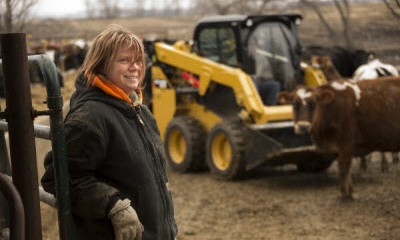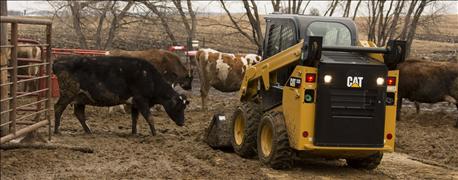April 20, 2016

Over the years, skid steer loaders have become an absolutely essential piece of equipment on modern day farms. Today's skid steer loaders are fast, powerful and, most importantly, versatile–which translates to significant improvements in efficiency and production. Fortunately, as skid steer performance capabilities continue to advance, so do the safety features available for them.
 Cat® D Series Skid Steer Loader exhaust systems cool the engine exhaust gas and direct it up and away from ground level to avoid disturbing or harming livestock.
Cat® D Series Skid Steer Loader exhaust systems cool the engine exhaust gas and direct it up and away from ground level to avoid disturbing or harming livestock.
Safety is especially important on the farm, as it not only protects the livestock, but also the machine operators and workers, who are often family members. Equipment damage and accidents can mean reduced production, decreased performance, lost revenue and potential operator injury. Additionally, violations of Occupational Safety and Health Administration standards can result in fines or even operation shutdown in severe cases.
In agriculture, four factors are particularly important to consider when spec'ing a skid steer loader: visibility, the exhaust system, emergency and everyday operation safety features.
Enhanced Visibility is Essential on the Farm
Many skid steer loader accidents and injuries occur because of poor visibility. Fortunately, today's top tier skid steer loaders are equipped with visibility enhancing features that help prevent injury to nearby workers and livestock. They also help minimize damage to buildings, fences, pens and the machine itself.
Narrow lift arms reduce blind spots. Extended window surfaces that extend all the way to the floor of the cab allow operators to see clearly out of both sides of the machine. They also provide a clear view of the machine's wheels and surrounding terrain. The side windows should not only provide good visibility, but also vent open to the front and rear to allow for communication between the driver and other workers on-site.
A rearview mirror is a must and should provide a panoramic view of the rear and sides of the machine. Rearview cameras are now being installed in newer model skid steer loaders–allowing operators to be fully aware of their 360-degree surroundings without having to turn their head.
Exhaust Systems Designed fro Accident and Injury Prevention
Many older model skid steer loaders and several current makes are equipped with exhaust systems that direct exhaust to exit out of the machine from the side and rear. It is easy to imagine the injury and damage this can cause, as these extremely hot exhaust fumes can harm people or livestock standing near the machine. They can also ignite airborne debris such as hay, bedding, feed and silage.
With the close working quarters on today's farms, it is important to find a skid steer loader with an exhaust system that cools the engine exhaust gas and directs it up and away from ground level. All air flow should exit the machine vertically rather than to the side or rear to avoid disturbing or harming livestock.
Safety Features to Protect the Operator in the Event of an Emergency
One of the most important safety precautions to practice while operating a skid steer loader, or any machine with lift arms and attachments, is to never exit the machine while the lift arms are raised. In the event of an unexpected engine shut down, it is important to have more than one method of lowering the lift arms so the operator can safely exit the machine. Hydraulic accumulators allow the operator to lower the loader arms if electrical power is available and the accumulator is charged. If the accumulator is not charged or if there is no electrical power, a dead engine lower lever allows the operator to manually lower the arms. Both of these features are not offered on every skid steer loader, so it's important to find a manufacturer that offers them as part of the standard equipment package.
Improving Safety During Everyday Operations
There have also been significant advancements to improve everyday operations safety on today's skid steer loaders. On many machines, safety features activate before the engine is even turned on–starting with the operator presence system, which requires the operator to be in the machine with the arm bars lowered before the engine will start. Once the engine is started, the parking brake will remain set and the hydraulic system locked out until the operator depresses a switch to activate the machine. It is also important to ensure that the skid steer loader is equipped with a spring-applied hydraulic release parking brake that engages and locks the hydraulics out automatically when the arm bars are raised or when the engine is not running.
Working on a farm, operators are often exposed to potentially harmful particles in the air. For this reason, fully sealed and pressurized cabs equipped with an air filtration system are another important consideration when spec'ing a skid steer loader. This helps to minimize inhalation of particles and dust that mix in with the air during everyday operations. These cabs are also quieter, which allows operators to focus on the tasks at hand and reduces their fatigue at the end of a long day.
As machine performance improves, so should safety measures and precautions. Skid steer loaders should always be equipped with proper safety features to support the performance capabilities of the machine. This is why owners need to research the latest safety guidelines, procedures and feature advancements when spec'ing or purchasing a new machine. It is important to also pass that knowledge along to their operators, who should be properly trained before work begins.
You May Also Like




